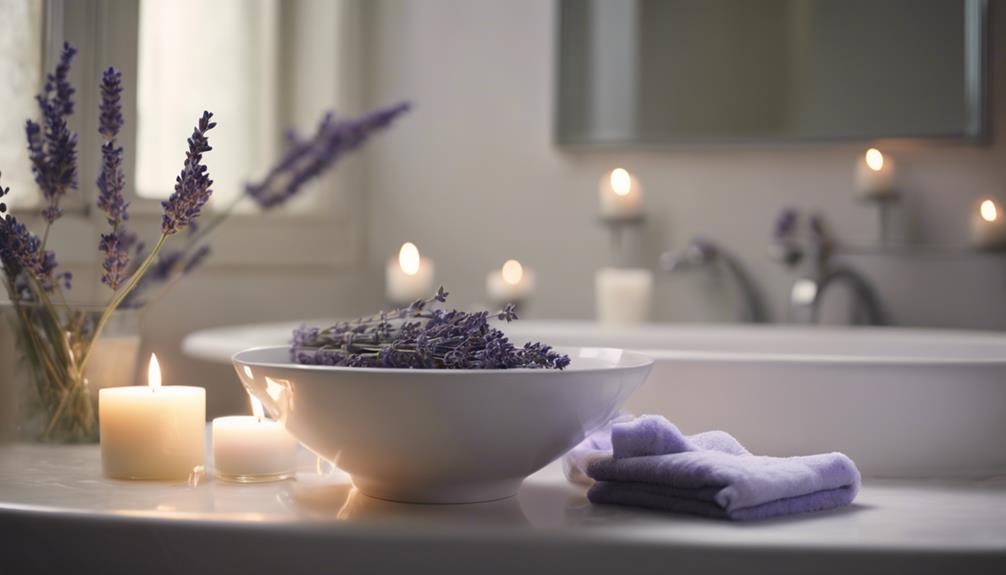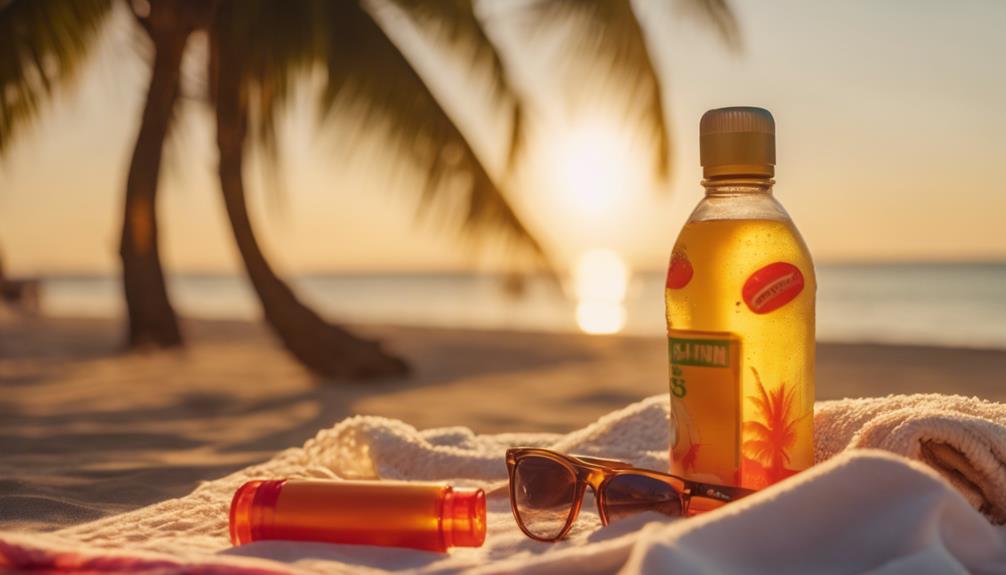So, you've tanned and now your skin's screaming for relief? Don't fret! Aloe vera gel is like your best friend, cooling and hydrating all at once. Coconut oil is another tropical miracle that'll lock in moisture while making you smell amazing! Ever thought of a milk soak? Just dip a cotton ball in cold milk, and your skin will thank you. Want to go the extra mile? Try an oatmeal bath or some chamomile tea for a soothing treat. And hey, witch hazel can help reduce redness too! Stick around, and you'll discover even more skin-loving tips!
Key Takeaways
- Aloe vera gel soothes and hydrates irritated skin, providing relief after sun exposure.
- Coconut oil deeply moisturizes and creates a protective barrier, promoting healing for sun-kissed skin.
- Cold milk applied with a cotton ball refreshes skin and helps prevent peeling post-tan.
- Oatmeal baths relieve inflammation and itchiness, offering a calming experience for sun-damaged skin.
Natural Remedies for Skin Recovery
When your skin feels irritated after tanning, natural remedies like aloe vera gel, coconut oil, and milk can provide the soothing relief you need.
Seriously, who doesn't love a little pampering after a day in the sun?
Aloe vera gel is like nature's cool-down spray—it soothes and hydrates your skin instantly.
Coconut oil? It's a moisturizing superstar that helps your skin heal while smelling like a tropical vacation.
And let's not forget milk! Its creamy goodness hydrates and refreshes, making your skin feel like a million bucks.
Benefits of Aloe Vera

Aloe vera is a powerhouse for your skin, offering soothing hydration and anti-inflammatory benefits that help alleviate irritation and promote healing after sun exposure.
Imagine this: you've enjoyed a day in the sun, but now your skin's feeling like a toasted marshmallow. Aloe vera swoops in like a superhero!
It cools down your skin and fights inflammation, making you feel so much better. Plus, it's great for moisturizing, so you won't be left feeling dry and flaky, which is just the worst, right?
You can apply it right from the plant or use gel from the store. Either way, your skin will thank you.
Coconut Oil for Hydration

After soothing your skin with aloe vera, consider using coconut oil for its intense hydration properties that help restore moisture to sun-exposed skin.
This magical oil isn't just for cooking; it's like a drink of water for your thirsty skin! When you rub it on, you're not just moisturizing—you're creating a protective barrier that locks in all that good stuff.
Plus, its anti-inflammatory properties can calm any redness or irritation, making your skin feel super comfy.
So, why not make it a part of your post-tan routine? Just remember to give it a little massage while applying, and your skin will love you for it.
Who doesn't want soft, glowing skin after a day in the sun?
Soothing Milk Applications

Soothing milk applications provide a gentle way to hydrate and refresh your skin after sun exposure. You might be surprised to learn that milk isn't just for cereal! Its lactic acid works like a charm, gently exfoliating while keeping your skin moisturized.
After a day in the sun, slather some on, and feel that instant relief. It's like a cool hug for your skin! Plus, using milk can help prevent that annoying peeling that happens after tanning. Who wants to deal with that, right?
Just grab a cotton ball, dip it in cold milk, and dab it on your skin. Your sun-kissed self will thank you, and you'll be back to feeling fabulous in no time!
Techniques for Oatmeal Baths

Transform your bath into a rejuvenating experience by adding finely ground oats to warm water for effective skin relief. It's like giving your skin a cozy hug! Just toss in about one cup of oats, and soak for 15-20 minutes.
| Step | Action | Tip |
|---|---|---|
| Gather materials | Get oats and warm water | Use a blender for a fine grind |
| Soak | Relax in the bath | Bring a book or listen to music |
| Rinse | Gently rinse off after soaking | Pat skin dry, don't rub! |
Oatmeal baths not only reduce inflammation but also soothe itchiness. Plus, it's a great excuse to pamper yourself. Who doesn't love a spa day at home? Enjoy!
Using Chamomile for Relief

Chamomile offers a gentle and effective way to relieve sun-damaged skin, making it an ideal choice for post-tan care.
You can brew a strong chamomile tea, then let it cool down. Once it's nice and chilly, soak a clean cloth in the tea and place it on your sun-kissed areas. How revitalizing is that?
Chamomile's anti-inflammatory properties will help reduce redness and irritation, so you'll feel more comfortable in no time. Plus, it's packed with antioxidants, which means it's working to heal your skin while you relax!
Who knew a cup of tea could do so much? So, grab that chamomile and treat your skin like the royalty it is—you deserve it!
Witch Hazel for Inflammation

After calming your skin with chamomile, consider using witch hazel to further alleviate inflammation and irritation from sun exposure.
This natural astringent works wonders by reducing swelling and tightening your pores, giving your skin a much-needed break. Plus, it helps soothe that annoying sunburn, leaving you feeling more comfortable in your own skin.
Just dab a little on a cotton ball and gently pat it on the affected areas. You'll love how it restores balance after those long hours in the sun!
And hey, who doesn't want to feel like they're pampering themselves a bit? So, grab your witch hazel and give your skin the TLC it deserves—you've earned it after all that sun!
Frequently Asked Questions
What Are the Best Foods to Eat for Skin Recovery?
To support skin recovery, you should eat foods rich in antioxidants, like berries and leafy greens, as well as healthy fats found in avocados and nuts. Hydration's key too, so drink plenty of water!
How Long Does Sunburn Typically Last?
Sunburn's sting usually lasts from three to six days, depending on severity. Soothing strategies like staying hydrated and applying cool compresses can greatly speed up skin's recovery and restore your natural radiance.
Can I Use Makeup After Tanning?
You can use makeup after tanning, but wait until your skin cools down and heals. Opt for lightweight, hydrating products to avoid irritation, and always guarantee your skin is well-moisturized before application.
Is It Safe to Swim After Sun Exposure?
It's best to wait a bit after sun exposure before swimming. Your skin needs time to recover. Chlorine and saltwater can irritate it further, so give your skin a chance to calm down first.
How Can I Prevent Future Sunburns?
Preventing future sunburns is as essential as guarding a treasure! Always apply broad-spectrum sunscreen, wear protective clothing, and seek shade during peak hours. Reapply every two hours to keep your skin safe and happy.
Conclusion
So, there you have it! Your skin's been through a lot, but with these natural remedies, it can bounce back like a beach ball on a sunny day.
Just imagine slathering on some cool aloe vera or soaking in an oatmeal bath that feels like a warm hug.
You've got the tools to turn that post-tan irritation into a soothing experience.
So go ahead, treat your skin right, and let it shine bright like the summer sun!










